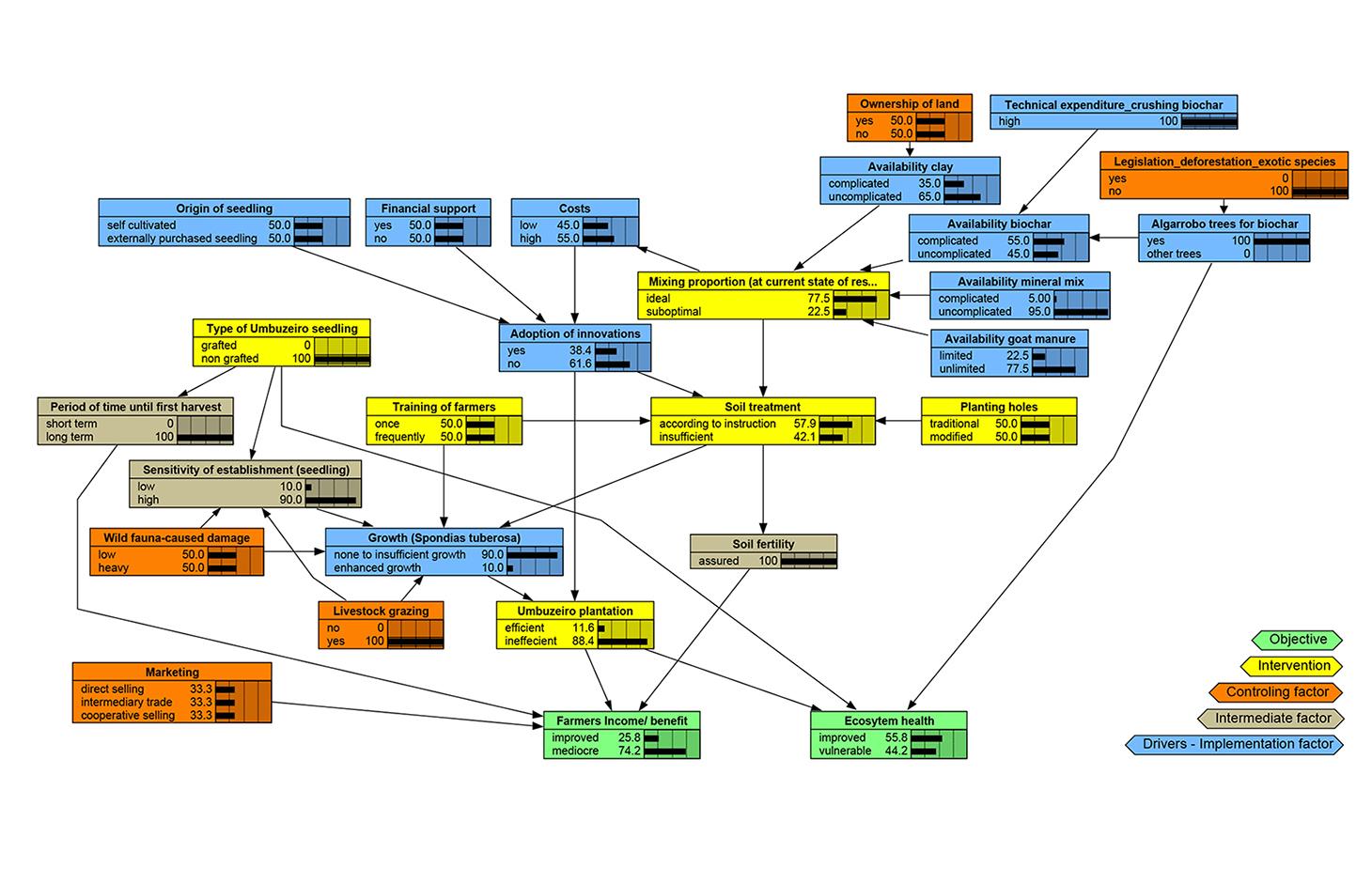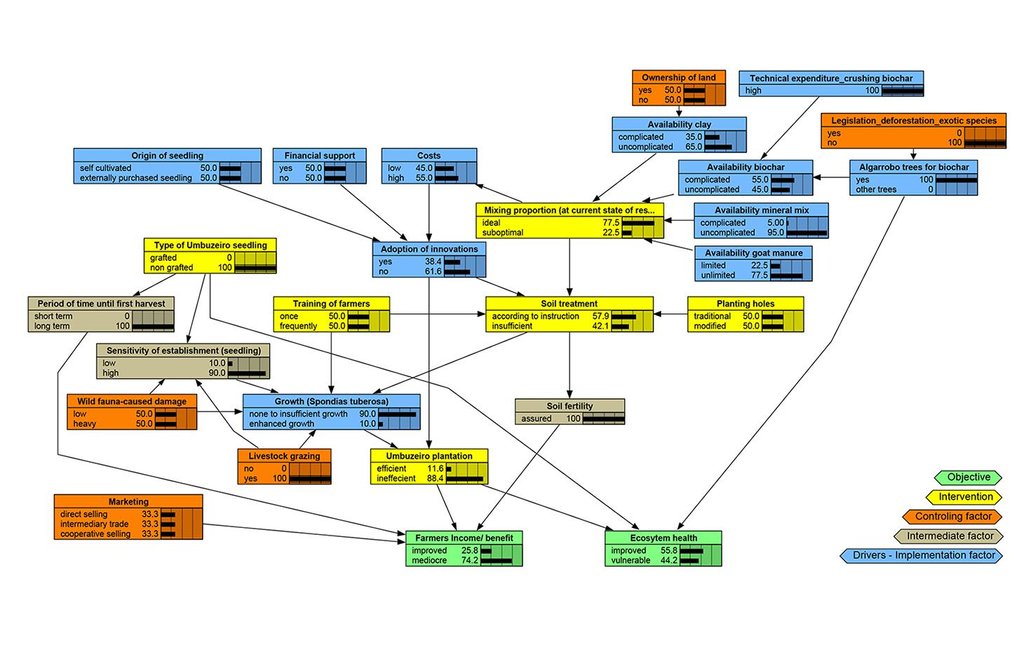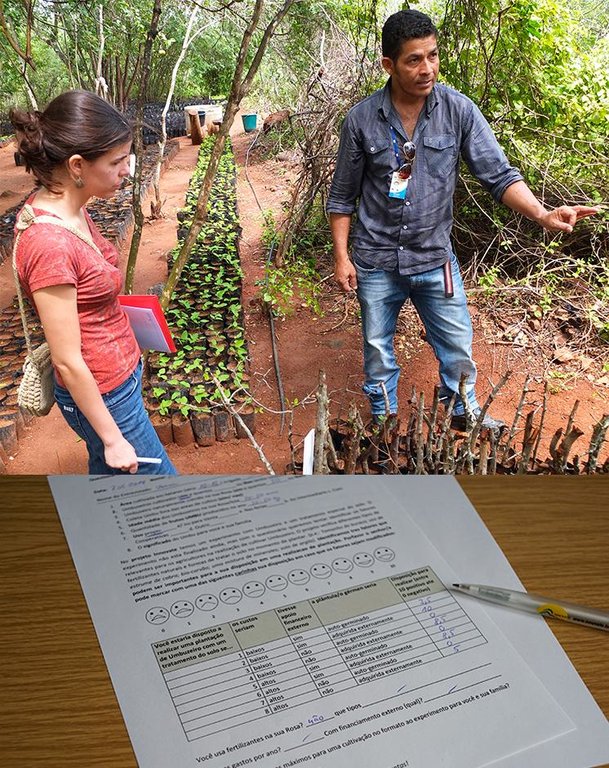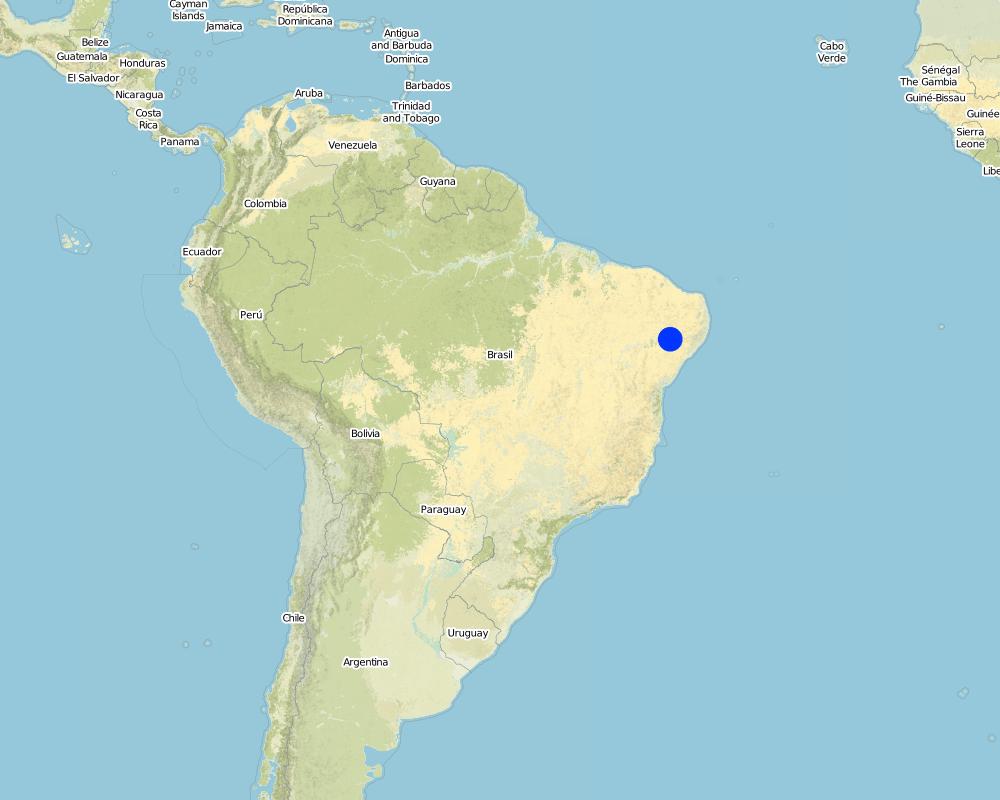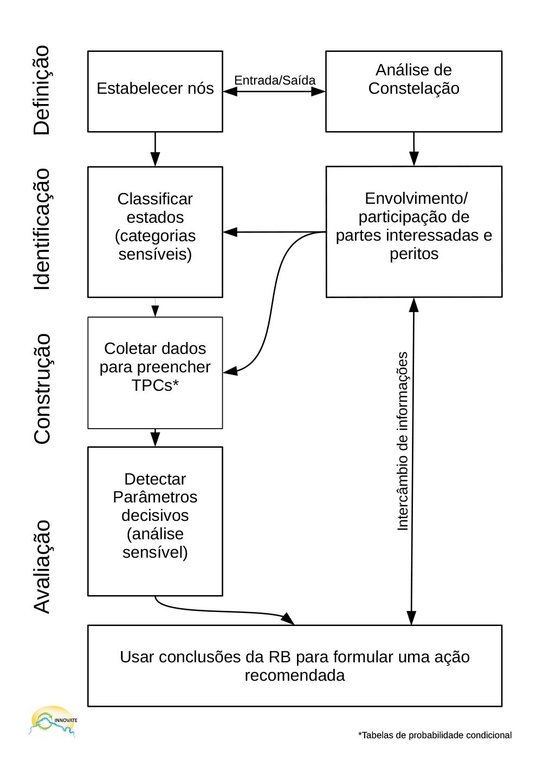Bayesian Network Approach [البرازيل]
- تاريخ الإنشاء:
- تحديث:
- جامع المعلومات: Verena Rodorff
- المحرر: –
- المُراجع: Deborah Niggli
Abordagem com Redes Bayesianas
approaches_1975 - البرازيل
عرض الأقسام
توسيع الكل طي الكل1. معلومات عامة
1.2 تفاصيل الاتصال بالأشخاص الرئيسيين لمصدر المعلومات والمؤسسات المعنية بتقييم وتوثيق النهج
متخصص في الإدارة المستدامة للأراضي:
متخصص في الإدارة المستدامة للأراضي:
Steinmetz Liron
steinmetz@tu-berlin.de
Berlin Institute of Technology (Technische Universität Berlin), Environmental Assessment and Planning Research Group
Secr. EB 5, Straße des 17. Juni 145, 10623 Berlin, Germany
اسم المشروع الذي سهّل توثيق/تقييم النهج (إذا كان ذلك على صلة)
Book project: Making sense of research for sustainable land management (GLUES)1.3 الشروط المتعلقة باستخدام البيانات الموثقة من خلال WOCAT
متى تم تجميع البيانات (ميدانيا)؟:
11/12/2015
يوافق جامع المعلومات والشخص (لاشخاص) الرئيسي لمصدر المعلومات على الشروط المتعلقة باستخدام البيانات الموثقة من خلال WOCAT:
نعم
2. وصف نهج الإدارة المستدامة للأراضي
2.1 وصف موجز للنهج
Assessment of the probability and effectiveness of management options or innovations to describe cause-effect-relationships and to make recommendations for action on sustainable land management in the Itaparica region in Northeast Brazil.
2.2 وصف تفصيلي للنهج
وصف تفصيلي للنهج:
The study focus was on the determinants behind the adoption of innovations developed under a scientific project. The specific innovation analysed was intended to benefit both the environment and local smallholder farmers: namely cultivating a multi-purpose, low-growing, to the prevailing harsh semiarid environment well-adapted tree species (Spondias tuberosa L. – so called umbuzeiro). The assessment method was selected as it allows the combination of qualitative and quantitative data, and can be applied even in data-scarce situations. Moreover, it allows downscaling from a broad overview to small-scale management.
Knowledge is collected from different disciplines to support decision-making through the inter- and transdisciplinary approaches of constellation analysis and Bayesian networks. A Bayesian Network (BN) is a probabilistic graphical model that represents a set of variables (elements, nodes) and their conditional dependencies. There are three input components to a Bayesian Network: (a) a set of elements representing factors relevant to a particular environmental system or problem, (b) the links between these elements, and (c) the conditional probability tables (CPTs) behind each node (element) used to calculate the state of the node. Collected data and ratings are arranged in a hierarchical Bayesian Network model in Netica software (Netica 5.12 - freeware up to 15 nodes).
The creation of a Bayesian Network model is as follows: the objectives and necessary interventions for the innovation process aimed at sustainable management are characterized, with scientists arranging a conceptual diagram, including the mapping of elements. States of the nodes are determined through study of the literature and expert consultation (by scientists, stakeholders and experts on related topics). In a final step, a sensitivity analysis is performed on the Bayesian Network to highlight crucial nodes with the highest influence on objectives in order to derive actions to be recommended.
Stakeholder participation is the core process of designing Bayesian Networks. In pre-consultations stakeholders help identifying major influencing factors and relationships. Assessments are compiled in interview sessions enabling the states of the nodes to be quantified later. In this case study, the stakeholders were farmers, farmer-supporting institutions, and expert in soils, vegetation and crops.
2.3 صور عن النهج
2.5 البلد/المنطقة/المواقع التي تم تطبيق النهج فيها
البلد:
البرازيل
المنطقة/الولاية/المحافظة:
Pernambuco, Brazil
مزيد من التفاصيل حول الموقع:
Itaparica Reservoir, Petrolândia
Map
×2.6 تواريخ بدء وإنهاء تنفيذ النهج
أشر إلى سنة البدء:
2014
سنة الإنهاء (إذا لم يعد النهج مطبقًا):
2016
2.8 الغايات/الأهداف الرئيسية للنهج
The principle of Bayesian Network modelling is the integration of multiple issues and system components, where information from different sources can be integrated, while also handling missing data and uncertainty. The outcome may be recommendations that support local management decision-making. As the method is strong in transdisciplinary knowledge integration, it has the potential to become one of the core methods in environmental management.
2.9 الظروف التي تمكن أو تعيق تنفيذ التقنية/التقنيات المطبقة بموجب النهج
المعايير والقيم الاجتماعية /الثقافية/ الدينية
- تمكين/تمكيني
توفر/الوصول إلى الموارد والخدمات المالية
- تمكين/تمكيني
Potential for financial support could be through national small-scale farmer programs; suitable government-sponsored credit programs, public and governmental institutions such as bulk purchasers of agricultural commodities (for instance SEBRAE in Brazil).
الإطار القانوني (حيازة الأراضي، وحقوق استخدام الأراضي والمياه)
- تمكين/تمكيني
المعرفة حول الإدارة المستدامة للأراضي، والوصول إلى الدعم الفني
- تمكين/تمكيني
Use available free programmes. Use of visual aids such as smileys for evaluation to make questionnaire more comprehensible.
3. المشاركة وأدوار الأطراف المعنية
3.1 أصحاب المصلحة المعنيون بالنهج وأدوارهم
- مستخدمو الأراضي المحليون/المجتمعات المحلية
Farmers of a resettlement community on dryland; Representatives of the indigenous tribe of Pankararu
- متخصصون في الإدارة المستدامة للأراضي / مستشارون زراعيون
Experts in soil and crop sciences; Expert in vegetation and biodiversity science of the Caatinga
- الحكومة الوطنية (المخططون، صانعو القرار)
Institute of Agriculture in Pernambuco (IPA); A private company as the hired institution by the National Institute for Colonization and Agrarian Reform - INCRA
- Company of plant breeding, seed science
3.2 انخراط مستخدمي الأراضي المحليين/المجتمعات المحلية في المراحل المختلفة للنهج
| انخراط مستخدمي الأراضي المحليين/المجتمعات المحلية | حدد من شارك وصف الأنشطة | |
|---|---|---|
| المبادرة/التحفيز | سلبي | Interviews |
| التخطيط | غير موجود | |
| التنفيذ | تفاعلي | Interviews |
| الرصد/التقييم | تفاعلي | Interviews |
3.3 مخطط التدفق (إذا كان متاحًا)
الوصف:
Simplified work flow of Bayesian Network (BN) showing different steps:
Defining: apply or use already applied constellation analysis (see A_BRA003en) for information and visualization of node setting for the BN model and for stakeholder identification.
Identifying: clarify objectives, implementation factors, interventions, intermediates and controlling factors. Give every node a state, e.g. date, temperature range, amount of precipitation, or a classification: high / low…
Building: Collect data to fill the conditional probability tables (CPTs) behind every node. Prepare questionnaires, ask experts and conduct a literature search. Avoid too much states and no more than four nodes indicating the next node. Finish the model by entering all data in a programme (e.g. Netica).
Evaluating: Compare different scenarios by changing the state of inputs (e.g. from low to high). Show a baseline (without changes), a most improved and least improved scenario to justify recommendations. Finally, hand over recommended actions to stakeholders.
المؤلف:
Liron Steinmetz, Verona Rodorff
3.4 اتخاذ القرار بشأن اختيار تقنية/تقنيات الإدارة المستدامة للأراضي
هل تم اتخاذ قرارات بشأن اختيار التقنية(التقنيات)؟:
- The approach was initiated by scientists.
اشرح:
The approach can be applied to SLM technologies, but also can be employed for other purposes. In our data-scarce case, the method was very helpful as able to deal with different data sources and types.
حدد على أي أساس تم اتخاذ القرارات:
- نتائج البحوث
4. الدعم الفني وبناء القدرات وإدارة المعرفة
4.1 بناء القدرات/التدريب
هل تم تقديم التدريب لمستخدمي الأراضي / الأطراف المعنيين الآخرين؟:
نعم
حدد من تم تدريبه:
- مستخدمو الأراضي
- موظفون ميدانيون/ مستشارون
شكل التدريب:
- من مزارع إلى مزارع
- مناطق العرض
شكل التدريب:
- workshops
المواضيع المغطاة:
Detecting decisive factors for an ideal scenario of implementation being adopted by land users. For the participants it was interesting to participate in preparing a joint view of their action space - this is generally known in its parts though not with its major interconnections and complexity. Participants especially acknowledged this value added for them.
4.2 خدمة استشارية
هل يملك مستخدمو الأراضي وصولا إلى خدمة استشارية؟:
كلا
4.3 تعزيز المؤسسات (التطوير التنظيمي)
هل تم إنشاء أو تعزيز مؤسسات من خلال هذا النهج؟:
- نعم، إلى حد كبير
حدد المستوى (المستويات) التي تم فيها تعزيز أو إنشاء المؤسسات:
- محلي
صف المؤسسة والأدوار والمسؤوليات والأعضاء وما إلى ذلك.
Decisive factors for the adoption of innovations were identified, including favoring cultivation techniques for Umbuzeiro agriculture (e.g. soil additives).
حدد نوع الدعم:
- بناء القدرات/التدريب
4.4 الرصد والتقييم
هل يشكل الرصد والتقييم جزءا من النهج؟:
نعم
إذا كانت الإجابة بنعم، فهل من المقصود استخدام هذه الوثائق للمراقبة والتقييم؟:
كلا
4.5 البحوث
هل كانت البحوث جزءًا من النهج؟:
نعم
حدد المواضيع:
- علم الاجتماع
- الاقتصاد / التسويق
- علم الايكولوجيا
- تكنولوجيا
أعط تفاصيل إضافية وأشر إلى من قام بالبحوث:
Research on the situation of local action and governance was a major driver for the workshops. University project members prepared and held the workshops, while also did extended interpretation and integration of results across a number of different workshops.
5. التمويل والدعم المادي الخارجي
5.1 الميزانية السنوية لمكون الإدارة المستدامة للأراضي في النهج المذكور
إذا لم تكن الميزانية السنوية الدقيقة معروفة، قم بالإشارة إلى نطاقها:
- < 2000
التعليقات (على سبيل المثال المصادر الرئيسية للتمويل/الجهات المانحة الرئيسية):
German Federal Ministry of Education and Research (BMBF) 100%
5.2 الدعم المالي/المادي المقدم لمستخدمي الأراضي
هل حصل مستخدمو الأراضي على دعم مالي/ مادي لتنفيذ التقنية/ التقنيات؟:
كلا
5.3 إعانات لمدخلات محددة (بما في ذلك العمالة)
- غير موجود
إذا كان العمل من قبل مستخدمي الأراضي مدخلاً جوهريًا، فهل كان:
- تطوعي
5.4 الائتمان
هل تم توفير ائتمان في إطار نهج أنشطة الإدارة المستدامة للأراضي؟:
كلا
5.5 حوافز أو وسائل أخرى
هل تم استخدام حوافز أو أدوات أخرى لتشجيع تنفيذ تقنيات الإدارة المستدامة للأراضي؟:
كلا
6. تحليل الأثر والتصريحات الختامية
6.1 آثار النهج
هل ساعد النهج مستخدمي الأراضي على تنفيذ وصيانة تقنيات الإدارة المستدامة للأراضي؟:
- لا
- نعم، قليلا
- نعم، باعتدال
- نعم، إلى حد كبير
The different scenarios of the BN tested highlight the good probability of adoption, which then can support sustainable land management.
هل ساهم النهج في تمكين الفئات المحرومة اجتماعيا واقتصاديا؟:
- لا
- نعم، قليلا
- نعم، باعتدال
- نعم، إلى حد كبير
The approach was conducted especially for smallscale farmers without sophisticated irrigation tecniques and as well for the indigenous tribe Pankararu.
هل أدى النهج إلى تحسن في مسائل حيازة الأراضي / حقوق المستخدمين التي أعاقت تنفيذ تقنيات الإدارة المستدامة للأراضي؟:
- لا
- نعم، قليلا
- نعم، باعتدال
- نعم، إلى حد كبير
The BN model offers alternative sources for soil additives in case land use rights are hindering availability.
هل أدى هذا النهج إلى تحسين الأمن الغذائي / تحسين التغذية؟:
- لا
- نعم، قليلا
- نعم، باعتدال
- نعم، إلى حد كبير
Not inmediately but a long-term influence is possible.
Did the Approach lead to improved livelihoods / human well-being?
- لا
- نعم، قليلا
- نعم، باعتدال
- نعم، إلى حد كبير
The different scenarios of the BN tested highlight the good probability of adoption, which can then benefit the livelihoods of adopters.
6.2 المحفز الرئيسي لقيام مستخدمي الأراضي بتنفيذ الإدارة المستدامة للأراضي
- زيادة الإنتاج
- زيادة الربح (القدرة)، وتحسين نسبة التكلفة إلى العائد
- المدفوعات/ الإعانات
- الوعي البيئي
- well-being and livelihoods improvement
6.3 استدامة أنشطة النهج
هل يمكن لمستخدمي الأراضي المحافظة على استدامة ما تم تنفيذه من خلال النهج (بدون دعم خارجي)؟:
- نعم
إذا كانت الإجابة بنعم، صف كيف:
Lessons learnt (especially on most favorable soil additive mixture) improve effectiveness of potential Umbuzeiro cultivation. Stakeholder pool of BN-creation comprises business networking opportunities for land users.
6.4 نقاط قوة/مزايا النهج
| نقاط القوة/ المزايا/ الفرص من وجهة نظر جامع المعلومات أو غيره من الاشخاص الرئيسيين لمصدر المعلومات |
|---|
| The combination of input variables from any given background is possible. |
| Via Bayesian networks changes to the modelled system can be tested prospectively. The space and potential effects of management options can be shown to decision makers. |
| Combining Bayesian networks with Constellation Analysis allows easy determination of major nodes of the model and supports the process of decision-making for sustainable land management activities; methods proved to be very transdisciplinary. |
6.5 نقاط الضعف/ العيوب في المنهج وطرق التغلب عليها
| نقاط الضعف/ المساوىء/ المخاطر من وجهة نظر جامع المعلومات أو غيره من الاشخاص الرئيسيين لمصدر المعلومات | كيف يمكن التغلب عليها؟ |
|---|---|
| The statistical component of the Bayesian network approach can be hard to grasp for less educated or near-illiterate stakeholder groups. | Percentages of probability estimations can be translated to a graphical equivalent (e.g. gradual scale of emoticons). |
7. المراجع والروابط
7.1 طرق جمع/مصادر المعلومات
- زيارات ميدانية، مسوحات ميدانية
- مقابلات مع مستخدمي الأراضي
7.2 المراجع للمنشورات المتاحة
العنوان، المؤلف، السنة، النظام القياسي الدولي لترقيم الكتب ISBN:
Rodorff V., Steinmetz L., Siegmund-Schultze M., Köppel J. (2015) Using Bayesian networks to depict favouring frame conditions for sustainable land management: Umbuzeiro-tree planting by smallholders in Brazil
متاح من أين؟كم التكلفة؟:
Session: Methods, tools and impact applications. Tropentag ‘Management of land use systems for enhanced food security - conflicts, controversies and resolutions’, September 16 – 18, 2015, Humboldt-Universität zu Berlin, Berlin, Germany
7.3 روابط للمعلومات ذات الصلة المتوفرة على الإنترنت
العنوان/الوصف:
Innovate project information
عنوان الرابط URL:
http://www.innovate.tu-berlin.de/v_menue/subprojects/sp7_decision_support_approach_and_project_coordination/sp7_rm1_decision_support_approach/parameter/en/
الروابط والوحدات المواضيعية
توسيع الكل طي الكلالروابط
لا يوجد روابط
الوحدات المواضيعية
لا يوجد وحدات مواضيعية


